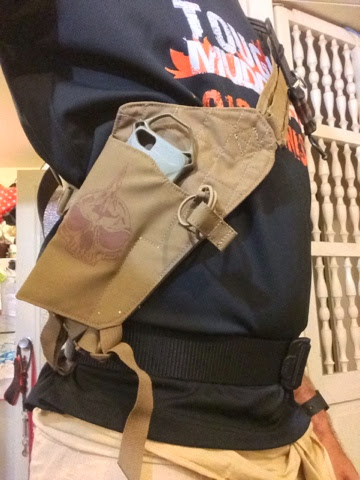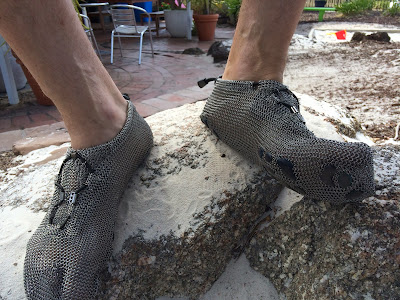This is the Walt torso holster from First Spear. I've been extremely happy with my First Spear OAGRE vest, which I've taken with me on my adventure and obstacle runs. These folks make some good gear, well thought out and put together.
The Walt will apparently fit the 1911, M9, 226, Glock, M&P, XD and other similarly sized pistols, none of which do I own, or have any reasonable expectation to do so any time soon (awww).
 That said, its a really nice piece, and I wanted to have it to have an alternative to my Hazard4 RG Harness or the venerable EDC harness before that.
That said, its a really nice piece, and I wanted to have it to have an alternative to my Hazard4 RG Harness or the venerable EDC harness before that. The holster is skinned in a grippy hypalon, which keeps it snug and slip free in position, and is lined with a micro-suede finish. Sewn to accommodate the trigger-guard, but reported not to take any optics or lights, a shock-cord and hypalon tab is set up for weapon retention. I found that the holster took my Strike Industries iPhone 5 SHOX case nicely.
Loops on the top and side of the holster are to affix the ITW G-hooks which give a quick but secure attachment for the baldric which as it happens, is set up with a single row of PALS/MOLLE loops along its length, until the webbing finishes of in an adjustable loop, for fitting. I mounted my awesome little ODDJob knife by SAR GlobalTool to mine, because it was a perfect addition to the rig, for the uses I have been putting it through.
The holster is designed to be worn under the right armpit, giving a left-hand pistol draw, which I thought was a little odd, but that's where I put my phone, anyway, so it worked out nicely for me.
I'd have to put the question out to the serious pistol carriers out there, as to your thoughts on this kind of set-up.
The bottom of the holster was open, to allow for longer barrels, and options for those of you who don't want to disturb your neighbors when shooting geckos and the lowest edge is set up for belt connection with the same kind of Quick Release buckle as seen on the OAGRE chest rig, being a looping hook-and-loop with press-stud to ensure a very secure connection, especially of the belt you are wearing features loop-fields to do just that.
Between the materials, the construction and the form, this is a pretty cool holster, with the gnarly First-Spear logo on the side, and its wrap-around PALS/MOLLE loops makes this a sadly under-utilised addition to my collection, but I like to pull it out from time to time when I can get away with a bandoleer ...




































